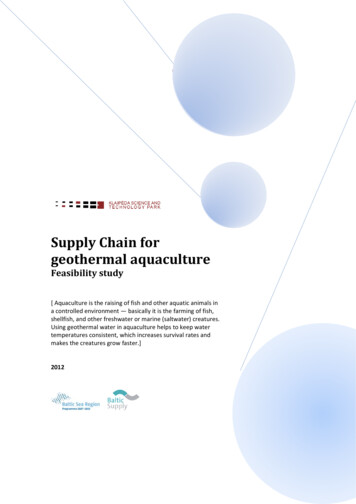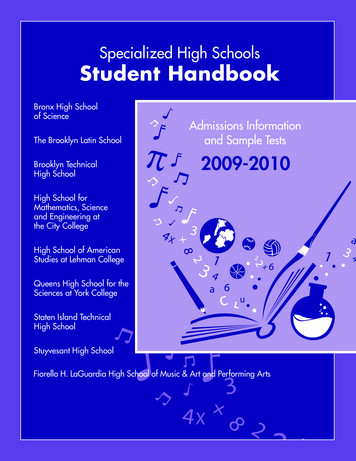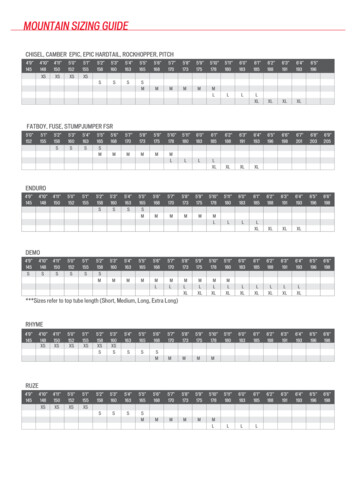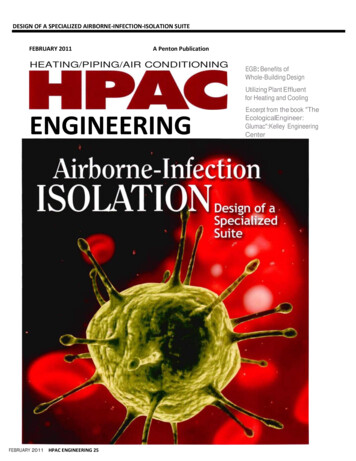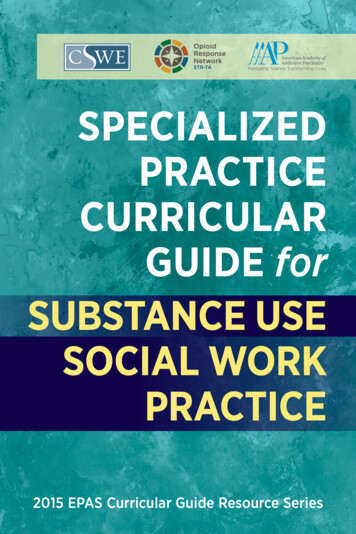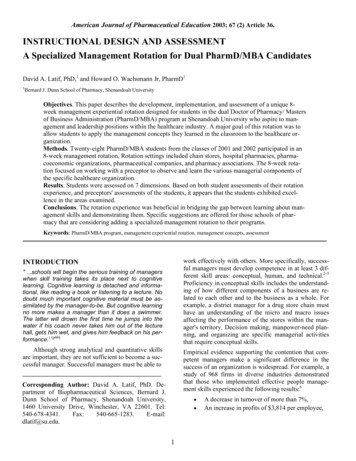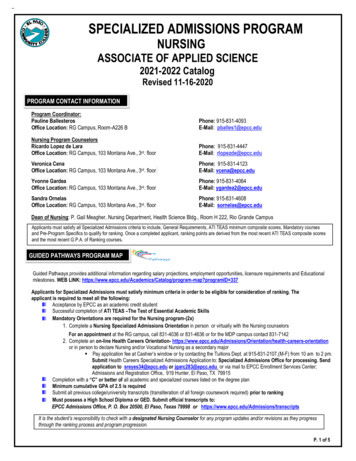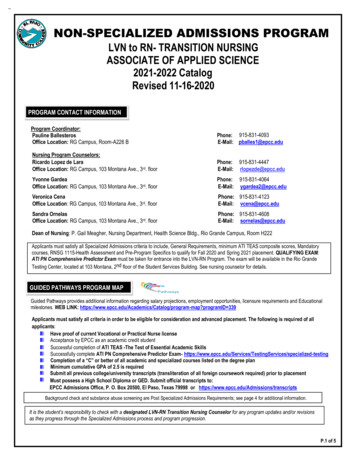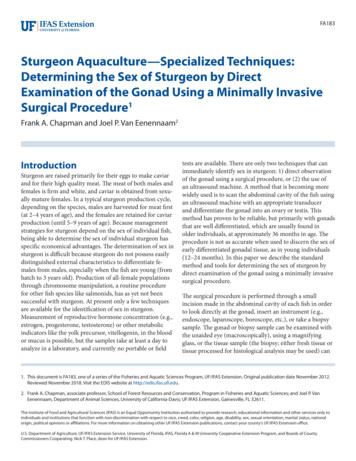
Transcription
FA183Sturgeon Aquaculture—Specialized Techniques:Determining the Sex of Sturgeon by DirectExamination of the Gonad Using a Minimally InvasiveSurgical Procedure1Frank A. Chapman and Joel P. Van Eenennaam2IntroductionSturgeon are raised primarily for their eggs to make caviarand for their high quality meat. The meat of both males andfemales is firm and white, and caviar is obtained from sexually mature females. In a typical sturgeon production cycle,depending on the species, males are harvested for meat first(at 2–4 years of age), and the females are retained for caviarproduction (until 5–9 years of age). Because managementstrategies for sturgeon depend on the sex of individual fish,being able to determine the sex of individual sturgeon hasspecific economical advantages. The determination of sex insturgeon is difficult because sturgeon do not possess easilydistinguished external characteristics to differentiate females from males, especially when the fish are young (fromhatch to 3 years old). Production of all-female populationsthrough chromosome manipulation, a routine procedurefor other fish species like salmonids, has as yet not beensuccessful with sturgeon. At present only a few techniquesare available for the identification of sex in sturgeon.Measurement of reproductive hormone concentration (e.g.,estrogen, progesterone, testosterone) or other metabolicindicators like the yolk precursor, vitellogenin, in the bloodor mucus is possible, but the samples take at least a day toanalyze in a laboratory, and currently no portable or fieldtests are available. There are only two techniques that canimmediately identify sex in sturgeon: 1) direct observationof the gonad using a surgical procedure, or (2) the use ofan ultrasound machine. A method that is becoming morewidely used is to scan the abdominal cavity of the fish usingan ultrasound machine with an appropriate transducerand differentiate the gonad into an ovary or testis. Thismethod has proven to be reliable, but primarily with gonadsthat are well differentiated, which are usually found inolder individuals, at approximately 36 months in age. Theprocedure is not as accurate when used to discern the sex ofearly differentiated gonadal tissue, as in young individuals(12–24 months). In this paper we describe the standardmethod and tools for determining the sex of sturgeon bydirect examination of the gonad using a minimally invasivesurgical procedure.The surgical procedure is performed through a smallincision made in the abdominal cavity of each fish in orderto look directly at the gonad, insert an instrument (e.g.,endoscope, laparoscope, boroscope, etc.), or take a biopsysample. The gonad or biopsy sample can be examined withthe unaided eye (macroscopically), using a magnifyingglass, or the tissue sample (the biopsy; either fresh tissue ortissue processed for histological analysis may be used) can1. This document is FA183, one of a series of the Fisheries and Aquatic Sciences Program, UF/IFAS Extension. Original publication date November 2012.Reviewed November 2018. Visit the EDIS website at http://edis.ifas.ufl.edu.2. Frank A. Chapman, associate professor, School of Forest Resources and Conservation, Program in Fisheries and Aquatic Sciences; and Joel P. VanEenennaam, Department of Animal Sciences, University of California-Davis; UF/IFAS Extension, Gainesville, FL 32611.The Institute of Food and Agricultural Sciences (IFAS) is an Equal Opportunity Institution authorized to provide research, educational information and other services only toindividuals and institutions that function with non-discrimination with respect to race, creed, color, religion, age, disability, sex, sexual orientation, marital status, nationalorigin, political opinions or affiliations. For more information on obtaining other UF/IFAS Extension publications, contact your county’s UF/IFAS Extension office.U.S. Department of Agriculture, UF/IFAS Extension Service, University of Florida, IFAS, Florida A & M University Cooperative Extension Program, and Boards of CountyCommissioners Cooperating. Nick T. Place, dean for UF/IFAS Extension.
be examined under a microscope. The greatest advantageof the surgical biopsy of the gonad is that it is the mostreliable method to identify the sex in sturgeon, especially atan early age (16–36 months), and to determine the stage ofsexual maturity of the gonads (the publications FA153 andFA154, explain the procedure for obtaining mature oocytesto determine their polarization index and thereby estimatematurity). The surgical procedure to obtain a biopsy ofthe gonad is the “standard” for comparison, to verify theaccuracy of alternative methods that attempt to identifythe sex in sturgeon. The technique is suitable for use in thefield and is safe, with minimal complications. In thousandsof surgeries we have performed since we developed thetechnique in the early 1980s, the incidence of reportedmortality has been very low. When mortalities have occurred, they have usually been associated with infections,especially when the fish have been handled in high watertemperatures (above 26 C) or in conditions of poor waterquality. The procedure is performed within a short periodof time, usually taking no more than two minutes per fish,and using relatively simple and inexpensive surgical tools.The technique does have disadvantages: it is still invasive(although minimally); potential for infection is increased;and determining the sex requires up to a couple of minutesto perform on each fish. Also, if a surgical suture is used,the cost for the material for each fish may be around 1USD. Finally, though the procedure is relatively simple,developing speed and skill requires some practice. Handlerswith no experience of this method are strongly encouragedto consult with a fish veterinarian and an experiencedaquaculturist before attempting the procedure.Materials A source of clean, aerated fresh water. Anesthetic compound. A tank to contain the fish. Fish handling and holding equipment: bobcat or backhoewith a lift net, live cars, stretchers, and sawhorses. Surgical tools: surgical gloves, scalpel handle (e.g., no.3) and blades (e.g., nos. 10, 11, 15). Tissue forceps:Adson-Brown (with 7x7 teeth) and Allis tissue forceps(4x5 teeth). A heavyweight needle holder/scissors (e.g.,Olsen-Hegar) to hold the needle and cut the suture.Absorbable suture materials (regular or antibacterial) fortissue ligation: Vicryl (polyglactin 910) size 0 or 1 withOS-6 or 4 reverse-cutting needle; PDS II (polydioxanone)sutures, size 1 with CP-1 cutting needle. Miscellaneous: data sheets or notebook (preferablywaterproof); pens/pencils; tackle box or similar containerin which to store the surgical tools, sutures, etc.; smallcontainer to hold the surgery tools in disinfectant; handand/or paper towels; small table on which to place thesurgery tools, sutures, and other sexing materials; sterilewipes and alcohol or iodine for cleaning/disinfectinginstruments in between fish; containers to serve as wastebaskets and to contain “sharps” for the used blades andsuture needles; a good, strong light source to allow forclear observation of the gonad.ProtocolMinimally invasive surgery to determine sex in sturgeon issafe and effective. A skilled operator can perform some 300to 500 surgeries in one day. Some elements of the procedure(i.e., method of anesthesia, and the decision whether tosuture or not) are limited by government or animal welfareregulations, the comfort level of the operator, or the potential for infection. The overall goal of the surgical procedurein a commercial operation is to remove or separate malesand to select females with obvious, easy-to-see ovaries.When the sex of the fish is difficult to determine, they areoften classified as “unknowns” and may be separated orsimply sold as meat fish.Capture and AnesthesiaFirst, sturgeon are gently captured using nets or stretchersto minimized injury and stress. The fish should then beanesthetized until they roll ventral side up and ventingof the gills slows down. Several drugs have been used forsedation and anesthesia of sturgeon. The only approvedanesthetic for use in fish in the USA is MS-222 (Tricaine-S;Finquel ), but unfortunately this is currently not approvedfor use in sturgeon. The drug requires treated fish to havea minimum of 21-day clearing (depuration) period beforethe fish can be used for food. MS-222 is known for itsacidic nature due to the formation of methane-sulfonicacid, especially in soft, low alkalinity water. The pH of thewater should be checked and if it is too low (less than 6.5)the anesthetic bath (e.g., 100 ppm) should be buffered withsodium bicarbonate. Two other drugs that are effectivebut that are not approved for use in the USA include2-phenoxyethanol (e.g., 300 mg/L), and benzocaine (e.g.,BZ-20 100–150 mg/L).Until anesthetic drugs are approved for use on sturgeon,non-drug options are the only alternatives. The clove oilderivatives Aqui-S 75-150 mg/L and Aqui-S20E (476-537mg/L) have been used. Aqui-S is not legal for use in theUSA; however, Aqui-S20E is currently allowed under anSturgeon Aquaculture—Specialized Techniques: Determining the Sex of Sturgeon by Direct Examination .2
FDA Investigational New Animal Drug (INAD) exemptionin hatcheries, with a withdrawal period of 3 days. Sturgeonhave been successfully anesthetized by immersing themin chilled water (10–12 C) and administering CO2 gascombined with pure oxygen to the water. After capture andanesthesia, the fish is placed ventral (abdomen) side up in astretcher. Experienced personnel usually will keep the fishout of the water no more than 2–3 minutes, but in case ofunexpected mishap, keep handy a fresh, non-chlorinatedwater source to irrigate the gills. In addition, properlydesigned stretchers with water drain holes on the uppersides and sawhorses that are slightly lower in the front willcreate a reservoir of water that can be just deep enough toimmerse the head and gill region of each fish and keep theabdominal region above water to permit the surgery.DisinfectionThe surgery should be conducted in as clean as possible,aseptic conditions. Wear surgical gloves and keep the surgical tools clean and disinfected. Minimal disinfection can beachieved by simply washing with detergents and soakingthe instruments in solutions such as 70% ethyl alcohol,65–90% isopropyl alcohol, or 1–3.5% iodine (note: iodineconcentrations greater than 3.5% are toxic to tissue anddo not provide additional disinfectant activity). Sturgeonssecrete copious amounts of mucus that appear to haveantibiotic properties, so the need for surface disinfectantsis optional. Actually, we do not recommend swabbing ofthe incision area with a disinfectant because many surgicalscrub solutions appear to irritate or even damage the fish’sskin and remove the naturally protective mucus coating. Ifthere is a great deal of mucus, a gentle swab of the incisionsite with a sterile gauze pad moistened with a dab of 1%iodine solution is all that is needed.Figure 1. Location of the abdominal incision on a white sturgeon, usedto visually examine the gonads during sex identification. The scalpelblade tip is located where the incision is made, approximately 3 to 4ventral scutes anterior from the pelvic fin and midway between theventral mid-line and scutes.Credits: Frank A. Chapman and Joel P. Van EenennaamUse a scalpel and tissue forceps to make the cut. Theincision should be 1–3 cm long; the length will dependon the specific method you use. You will need a shorterincision if you use an endoscope to see the gonad and asomewhat longer one if you use forceps to remove a sampleof gonad tissue. A single through-cut, made without liftingthe blade will best allow you to avoid tearing the skin, andwill prevent excessive bleeding and encourage healing. Themid-line ventral skin in sturgeon is poor in blood supply, somake the cut slightly off-center through the relatively wellvascularized muscle tissue in order to enhance the healingprocess. Make a swift incision and make your examinationof the gonad as rapid as possible to take advantage of theslight delay before the incision starts to bleed.IncisionExaminationThe preferred surgical incision area is below the liver onthe right side of the fish, where the right gonad may berelatively easily exposed and accessed; the gonad on theleft side is less accessible because it is more covered by thespleen. The cut should be some 1–5 cm off the ventral midline, opposite 3–5 ventral scutes anterior from the pelvic fin(Figure 1). This should place the opening directly or almostdirectly above the gonad. The exact location for the incisionwill depend greatly on the species and the unique physicalcharacteristics of each individual fish—sturgeon displayconsiderable variation in body conformation and scutepatterns. In most cases, the gonad should be immediatelyvisible through the incision.In some cases the gonad is very small or fatty. A pair of Allis tissue forceps (4x5 teeth) can be used to help manipulateand roll the gonad so that the ovary or testis tissue can beobserved; if necessary the forceps also can be used to takethe biopsy. You will need a bright head- or hat-mountedflashlight, shop lights, or some other type of lighting toclearly observe the gonad; some people are proficient atseeing the gonad simply in daylight by placing the fish at aproper angle.The gonads in sturgeons are paired and consist both offatty (adipose) tissue and the “germinal tissue,” where theactual eggs or sperm develop (Figures 2). The color of thegonad varies (white to yellow to orange) depending onhusbandry conditions, such as diet. The greatest challengeSturgeon Aquaculture—Specialized Techniques: Determining the Sex of Sturgeon by Direct Examination .3
is to differentiate the ovarian tissue from the adipose tissue.The female ovarian tissue is typically darker than thetestis, usually an off-white to yellowish color. However, thedistingu
Sturgeon Aquaculture—Specialized Techniques: Determining the Sex of Sturgeon by Direct Examination . 2 be examined under a microscope. The greatest advantage of the surgical biopsy of the gonad is that it is the most reliable method to identify the sex in sturgeon, especially at an early age (16–36 months), and to determine the stage of sexual maturity of the gonads (the publications .
